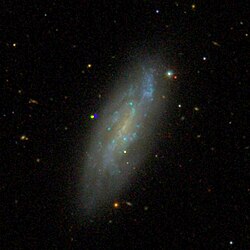| NGC 4294 | |
|---|---|
 SDSS image of NGC 4294 | |
| Observation data (J2000 epoch) | |
| Constellation | Virgo |
| Right ascension | 12h 21m 17.8s [1] |
| Declination | 11° 30′ 38″ [1] |
| Redshift | 0.001184 [1] |
| Heliocentric radial velocity | 355 km/s [1] |
| Distance | 55 Mly (17 Mpc) [1] |
| Group or cluster | Virgo Cluster |
| Apparent magnitude (V) | 12.5 [1] |
| Characteristics | |
| Type | SB(s)cd [1] |
| Size | ~52,000 ly (16 kpc) (estimated) [1] |
| Apparent size (V) | 3.2 x 1.2 [1] |
| Other designations | |
| KCPG 330B, VCC 465, IRAS 12187+1147, UGC 7407, MCG +02-32-009, PGC 39925, CGCG 70-24, SDSS J122117.82+113037.6 [1] | |
NGC 4294 is a barred spiral galaxy [2] with flocculent spiral arms [3] located about 55 million light-years away [2] in the constellation Virgo. The galaxy was discovered by astronomer William Herschel on March 15, 1784 [4] and is a member of the Virgo Cluster. [5] [6] [7]
Contents
- Physical characteristics
- Interaction with NGC 4299
- HI tail
- Black Hole
- See also
- References
- External links
NGC 4294 appears to be undergoing ram-pressure [8] [9] stripping edge-on. [8]